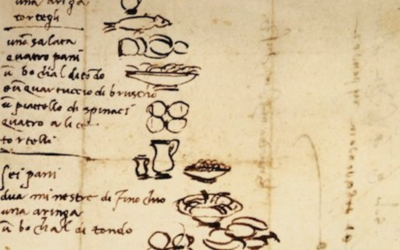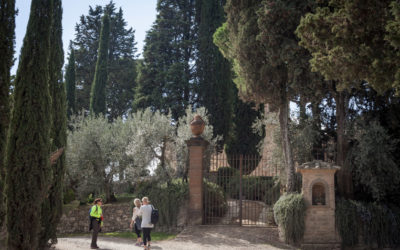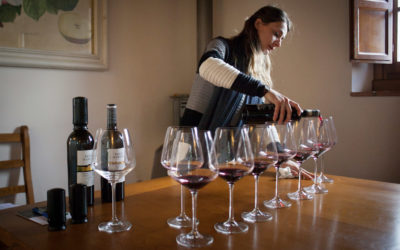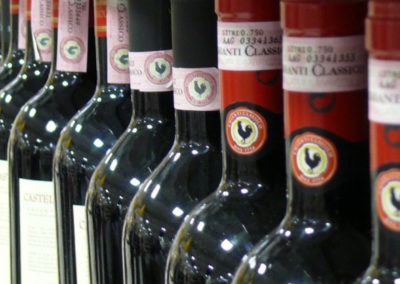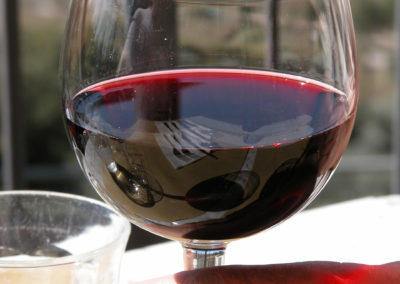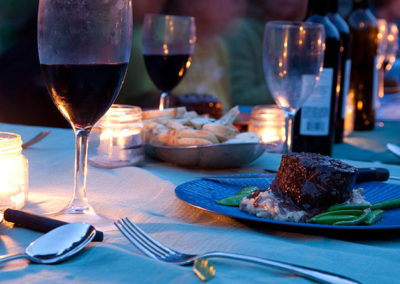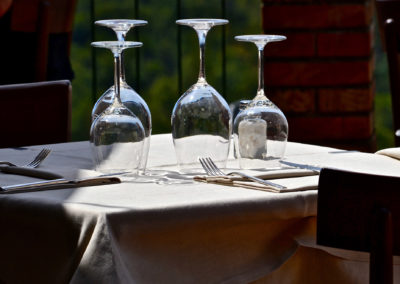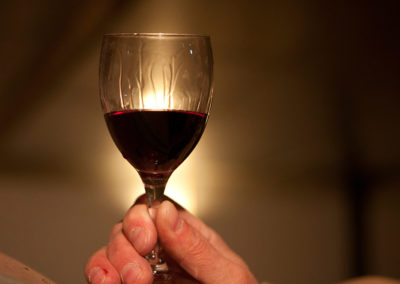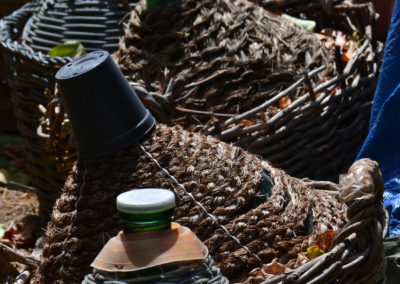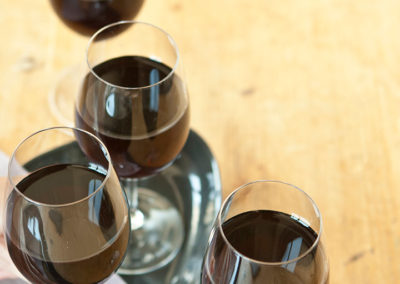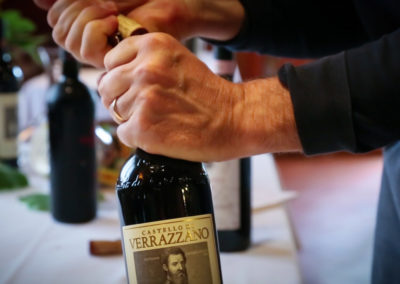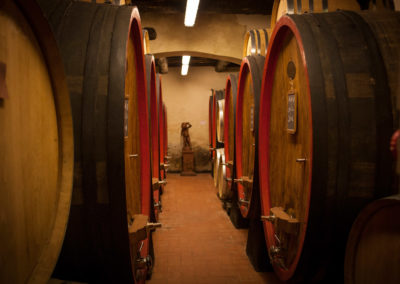In 1927, Carol Sicbaldi’s grandfather, a man named Pietro Sicbaldi, was born in a tiny village called Villaromagnano (AL) in Piedmont, Italy. One of seventeen siblings, he immigrated to America with his cousin. The Land of Golden Dreams and Opportunity.
They worked the fields for years until Pietro saved up enough money to buy a large piece of property and start a fruit tree farm. This is what he knew best. Little did he know that this was the beginning of a family business that would thrive on through three generations.
Pietro met Cesarina, in the mid 1920s at a social club dance for immigrants. They fell in love, married and had three children–all of whom worked on the family tree farm.
Today, Carol’s eldest brother Michael continues to carry the farm forward, managing a garden center and floral shop.
Carol is one of 14 grandchildren. Her insatiable curiosity for travel and discovering the world and languages – brought her around the world and eventually to Italy to perfect the language and to meet Pietro’s remaining relatives; her first, second and third cousins. Her first casa away from casa remains in that very same village, Villaromagnano, where Nonno Pietro was born.
Carol’s combined love of sport, food, wine and Italy brought her to Italy leading walking and bicycle tours up and down the peninsula from 1993-2000, when she moved permanently to Italy. For almost two decades now, Carol has created, designed, and guided active foodie trips working closely with a range of professional Italian chefs, wine producers, farmers, sommeliers and other industry experts.
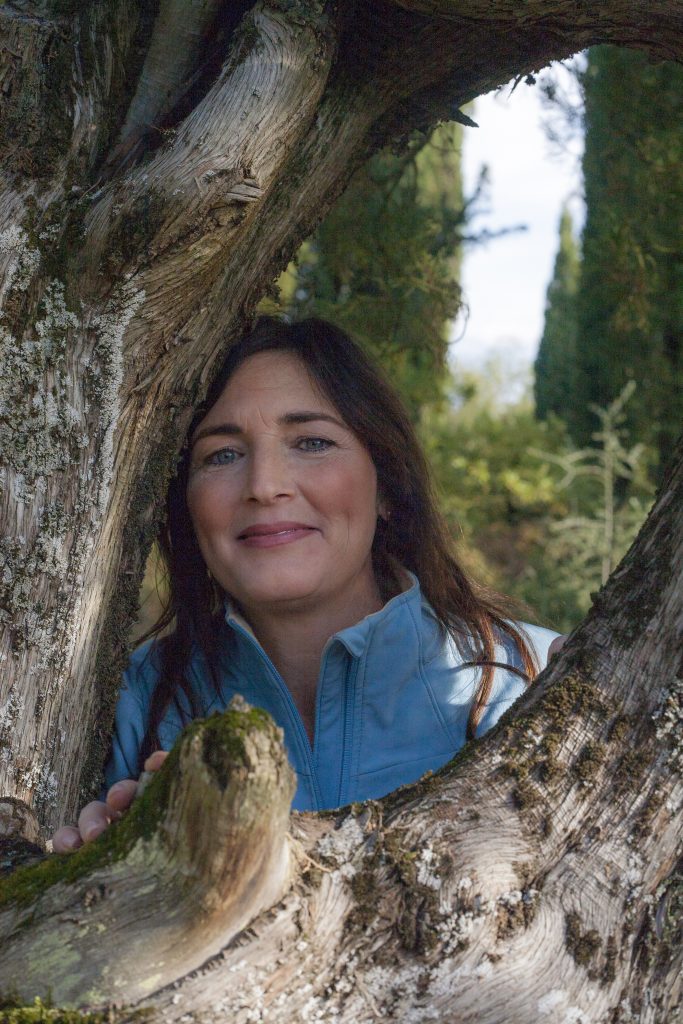
“Carol has a way of creating one of a kind experiences which allowed us to immerse ourselves in the region. I recall not feeling so much like a tourist but more like a thread of the tapestry of the region. Carol created the experience and allowed each of us to draw from it in our own way.” -Sherry T. North Raleigh, NC
Her love for Italy, now her home for almost 18 years, is a life passion. She lives, eats and breathes all things Italian and delights in sharing the most obscure, unknown, delightful, whimsical, delicious and unexpected aspects –and especially the beautiful people–of her beloved country, Italia.
LOOKING FOR AN ACTIVE, ITALIAN FOODIE EXPERIENCE BUT NOT SURE HOW OR WHERE TO GO? SEVERAL DAYS IN A SPECIFIC REGION OR A WEEK LONG VACATION COMBINING DESTINATIONS?
WE DO IT ALL.
Carol’s Moveable Feast is a unique collection of active and/or food and wine experiences primarily in Italy curated by Carol Sicbaldi. With more than 20 years work experience in active-adventure foodie travel, creating eno-gastronomic (wine-food) experiences and/or food and wine seminars, Carol’s expertise speaks for itself with each and every genuinely orchestrated one-of-a-kind one day or multi-day trip she designs.
Carol is the magical curator and orchestra conductor waving her wand to bring together incredible food experiences, tastings, cooking lessons, demos & techniques, expert wine knowledge, phenomenal table settings, amazing (hot and cold) artful “pop-up” picnics in the woods or meals in vineyards, music.
Top this all off with total union of presentation and place.
With the most exclusive relationships in the industry (after years of creating and leading trips for food industry professionals+active travelers), Carol has created an absolutely unique roster of
“foodie” experiences unlike anything out there. There is no comparison. This is not a feast for all but rather for those lucky enough to attend. An insider sharing the secrets to a delicious life fulfilled.
VIP ALL AROUND.
WONDERING WHO MAKES THE BEST GELATO IN THE TINIEST, MOST OBSCURE VILLAGE IN THE APENNINES? SHE’LL FIND OUT.
INTERESTED IN LEARNING THE INS AND OUTS OF RAISING THE COVETED BLACK PIGS OF PARMA? SHE’LL TAKE YOU THERE, AND DRIVE YOU AROUND IN A GOLF CART TO VISIT THE PIGS.
SHALL WE PICK THE FRESHEST INGREDIENTS POSSIBLE FROM AN ORGANIC GARDEN AND COOK THEM UP WHILE SIPPING CHIANTI CLASSICO?
HOW ABOUT A WALK WITH ANTONIO THE TRUFFLE HUNTER AND HIS TRUFFLE DOG PINA?
A GORGEOUS WALK TO A TRADITIONAL TUSCAN BASKET WEAVERS’ HOME WHERE YOU SPEND THE AFTERNOON EATING FRESH TUSCAN FOOD AND LEARNING ABOUT THIS BEAUTIFUL, SLOWING-DISAPPEARING ARTISAN CRAFT?
HOW ABOUT A COMPREHENSIVE OLIVE OIL TASTING WHEREBY SHE TEACHES YOU HOW TO COMPARE OILS FROM SICILY, UMBRIA, LIGURIA AND TUSCANY?
DOESN’T EVERYONE WANT TO MEET THOSE RARE, SMALL WINE PRODUCERS WHO HAVE A GREAT STORY TO SHARE AS WE SAMPLE FROM THE BARREL?
A VISIT WITH A TUSCAN TEA GROWER?
These are just some of Carol’s favorite places to share and stories to tell.
A Moveable Feast is about moving, in nature, or within a place or territory while enjoying the feast at hand; a celebration of food, wine and, of course, the lovely, passionate Italian people behind it all.
Contact us here to create your own, private, unique itinerary.
Carol’s Moveable Feast offers a range of active foodie trips which are fully supported and are accompanied by Carol and/or one of her amazing expert guide staff.
Most of our guided tours are bespoke—tailored to your likes and interests.
Accommodations, most meals, guide services, visits, van support (where needed), luggage transfers and entrance fees are included.
CELEBRATING ITALY
Level: Easy/Active Foodie
This trip is ideal for yoga groups, runners and walkers alike or friends traveling together. It is based from a villa property with a large, comfortable space to practice yoga. The itinerary provides a unique, inside opportunity to explore a less traveled and lesser known, spectacular corners of Tuscany: by foot, driving a Fiat 500m, in nature, with daily yoga practice, exploration and experiences focused on food, culture, Tuscan life (meeting and spending time with Tuscans).
We are local and we share an authentic experience of daily life.
Departures: late March and mid-October.
LINK TO ITINERARY OR (Download PDF)
“I would like to thank Carol for her care and attention to detail in creating a life-altering experience; for her enthusiasm, professionalism, trusted supplier relationships, and for the knowledge of our superior products she shared so freely and greatly.” -Sherry T., Whole Foods Market.
The Original Takeout, Michelangelo Style
What, one may ask, does a genius Renaissance artist eat for dinner?
As a mad lister and journal writer it was a pleasure to recently discover a well-preserved illustrated 500-year old shopping list at the Casa Buonarroti museum in Florence “scribbled” out by the Great Michelangelo– to his servant–who was most likely illiterate. Dated March 18, 1518, this beautiful list was written on the backside of an old letter. By the same guy that painted the Sistine Chapel!

The curious feast drawn out by this reverential personality included foods that were to be spread out over three days of meals, including corresponding portions of bread.
An elegant herring floats in the air, while bowls overflow with salad and anchovies. Two dishes of stewed fennel are sketched side by side, and when asking for a smaller amount of dry wine, Michelangelo carefully drew a small wine jug next to a larger one.
This remarkable ancient shopping list consists mostly of vegetables, fish, wine, and bread. It’s been suggested that since it was written around the time of Lent, when eating meat was not allowed, he was clearly playing by the rules. Scholars also agree that this was a very upscale menu for an artist of the time, but Michelangelo surely spend many of his meals breaking bread with nobility.
It’s separated into three days by horizontal lines, and includes requests such as “pani dua” (two loaves of bread), “un aria” (a herring), and “un bocal di vino” (a quart of wine), tortelli, two fennel soups, four anchovies and so on.
“The list could surely go on, and there is nothing more
wonderful than a list, instrument of wondrous hypotyposis”
Umberto Eco, The Name of the Rose

As Kurt Buzard writes in his blog Travel to Eat, “We compose ephemera every day in the form of disposable to-do lists, directions to unvisited destinations, notes to people we know or have never met, and shopping lists of this kind. This kind of writing powers our ordered experiences, as ephemeral texts chart encounters before being rendered useless. Collected, disposable shopping lists create an archive of everyday artifacts that we can peruse for traces of the everyday both past and present. I thought I would present a few more examples and explore the origins of writing such lists.”
According to Wikipedia, Michelangelo was abstemious in his personal life, and once told his apprentice, Ascanio Condivi: “However rich I may have been, I have always lived like a poor man.” Condivi said he was indifferent to food and drink, eating “more out of necessity than of pleasure” and that he “often slept in his clothes and boots.”

What we certainly know about Michelangelo is that he was a perfectionist and never wanted anyone to see his work before it was finished. The survival of this list is astounding. Only around 600 of Michelangelo’s sketches still exist. The year 1518 is the same year Michelangelo burned many of his early drawings, and 46 years later, he ordered many of his papers to be torched in anticipation of his death.
In this down-to-earth-shopping list we see that not only did the true Renaissance Man pursue a variety of interests, but he applied his mastery equally to tasks exceptional and mundane. Which, of course, in this case, surely renders the mundane exceptional!
For further musings about this list, other genius lists and the origins of writing, check out Buzard’s the full story on Travel to Eat.
The Meandering Maven

In 1927, Carol Sicbaldi’s grandfather, a man named Pietro Sicbaldi, was born in a tiny village called Villaromagnano (AL) in Piedmont, Italy. One of seventeen siblings, he immigrated to America with his cousin. The Land of Golden Dreams and Opportunity.
They worked the fields for years until Pietro saved up enough money to buy a large piece of property and start a fruit tree farm. This is what he knew best. Little did he know that this was the beginning of a family business that would thrive on through three generations.
Pietro met Cesarina, in the mid 1920s at a social club dance for immigrants. They fell in love, married and had three children – all of whom worked on the family fruit farm.
Today, Carol’s eldest brother Michael continues to carry the farm forward, managing a garden center and floral shop.
Carol is one of 14 grandchildren. Her insatiable curiosity for travel and discovering the world and languages brought her across the globe and finally to Italy to perfect her ancestor’s mother tongue and to meet Pietro’s remaining relatives; her first, second and third cousins. Her first casa away from casa remains in that very same village, Villaromagnano, where Nonno Pietro was born.
Carol’s combined love of sport, food, wine and Italy lead to her guiding walking and bicycle tours up and down the Italian peninsula from 1993-2000, when she moved permanently to Italy. For almost two decades now, Carol has created, designed, and guided active foodie trips working closely with a range of professional Italian chefs, wine producers, farmers, sommeliers and other industry experts.
12 Tips on Wine Tasting
With over 800 wine grape varieties, 20 uniquely designated winegrowing regions, and hundreds of years of winemaking history on the books, Italy’s wine scene is a glorious adventure from grape to glass.
So, I asked my great friend Bernardo Conticelli, extraordinary Florentine sommelier to share his wine-tasting basics: what to be aware of as you approach the glass, take your first glorious sip, and actually send the wine “down the hatch.” He describes the simple steps as well as the smallest and most subtle things you might not think to notice–if not brought to your attention.
In addition to Bernardo’s 13 beginner steps to drinking wine, we’ve added colorful commentary and tips from certified sommelier and winemaker Giuditta Parisi.
Saluti! “Cin Cin”
13 Simple Steps for Tasting Wine
1. Look carefully at the wine in the glass and check the color: is it white, pink or rosé?
2. Determine the intensity of the color.
White wines: The deeper and more full-bodied it is, the richer and more matured it is.
Red wines: If it’s lighter and you can read through the glass, it’s usually from specific grape varieties like Sangiovese, Nebbiolo, Pinot Noir etc. If it’s deeper, it’s usually from grape varieties like Merlot, Cabernet Sauvignon, Malbec, Montepulciano, Nero d’Avola.
3. Check the rim of the red wine.
If the rim of the glass holds the same intensity of color of wine in the center, it’s a young wine.
If the rim is a more brick/tawny color, it means it has been aged in barrels and in bottles for some years.
4. Carefully swirl the glass two to three times, gently moving the wine inside to let the volatile aromas come up toward you.
“Hold the glass at the base of the stem (and not the bowl of the glass) to avoid heating up the wine or so that your own skin is not in direct contact with the glass and therefore doesn’t affect the overall olfactory evaluation of the wine.”
-Giuditta Parisi
Certified Sommelier & Winemaker at Nostra Vita Winery in Montalcino, Tuscany
Smell the wine and notice what you smell. The aromas can be floral, fruity and/or spicy.
Remove your nose from the glass—just 4 to 5 seconds are enough. Then move the glass away and swirl it around again in a circular motion.
7. Repeat this swirling action 2 to 3 times before sipping so you can better discover all the aromatic complexities of the wine.
8. Taste the wine. Take a sip of the wine and keep it in your mouth for a few seconds, moving it all around your mouth before you swallow.
9. Pay attention to your mouthful: Every aspect of your mouth will give you information about the wine.
10. Notice acidity. Do you feel some tingling at the bottom sides of your mouth? Does your mouth start watering and produce saliva? This means the wine hold a very good acidity.
11. Notice tannins. If you feel some dryness or astringency in center of your tongue, those are the tannins producing this sensation. Red wines usually have tannins, while white and rosé wines do not.
12. Observe the body of the wine. If It feels like it’s filling your mouth, it’s a full-bodied wine. If it feels quite light and vertical and goes straight down your throat, it’s a light-bodied wine.
13. Repeat steps 1–12 with other wines until you find a vintage you like to take home!
“I suggest women avoid wearing strong perfumes before the tasting to avoid disguising or covering up the taste and natural odors of the wine. And, don’t wear lipstick!”
-Giuditta Parisi
Certified Sommelier & Winemaker at Nostra Vita Winery in Montalcino, Tuscany
How to Read an Italian Wine List
Most wine lists do not give you very much information beside the price, producer, and vintage. It’s wonderful when a wine sommelier is close by to help guide you. But when there’s no one to assist you, begin by decoding the following pertinent information:
Producer
The producer’s name can either be a single producer like Valentini, a cooperative such as Produttori del Barbaresco (56 member group) or a larger wine brand such as Ruffino. Knowing what type of producer can be helpful in understanding if the wine is rare or easy to find.
Type of Wine
Like France, Italian wines are often named after a region and each region is classified. For instance, a wine labeled Chianti Classico DOCG is from a sub-region of Chianti in Toscana that requires a minimum composition of 80% Sangiovese grapes. Alternatively, a “Named Wine” like Ruffino “Modus” on an Italian wine list (classified as IGT) is an atypical blend of unclassified grapes. Super Tuscan falls into this category.
Region
Each of the 20 Italian wine regions specialize in different types of wine and different grape varieties. Learning the basics of the leading Italian wine regions will help you read an Italian Wine list.
Vintage
Vintage variation greatly affects the produce of Italy. As a general rule, older vintages tend to have less prominent tannin.
Bernardo Conticelli
Sommelier, Wine and Olive Oil Producer
Bernardo Conticelli is an expert Italian wine sommelier, wine marketer, and winemaker himself.
He lives between Florence and Paris where he collaborates with foreign companies to organize tasting courses, introducing the vast geography of Italian wines. Bernardo also makes his own Sangiovese wine with two fellow friends and wine lovers Adriano Zago and Ciro Beligni. They grow their vines at 600 meters in Lamole, in Chianti Classico. Vinified first in stainless steel, then terracotta amphora, then wood, it’s a pretty wine with high cherry notes that are gorgeous on the palate.


